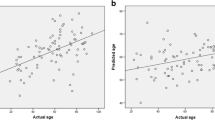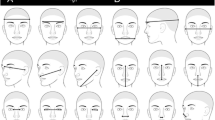Abstract
This paper presents a method for estimating the skeletal age of children based on the centroid size of their face and their basicranium, derived from the three-dimensional coordinates of anatomical landmarks. The sample consists of computed tomography scans of 127 children (54 boys, 73 girls) of mixed origin living in the area of Toulouse (France), ranging in age from a few days to 18 years. The purpose of the present investigation was, first, to increase the variety of age-related structures theoretically available for pediatric skeletal age estimation and, second, to devise a method that can be applicable from early postnatal age to the end of adolescence with a satisfactory accuracy independent of age and even a better accuracy with greater age. We examined the relationship between the chronological age and the centroid size, calculated by using geometric morphometric methods and a linear model. With the aid of cross-validations, the statistical analysis indicates that the centroid size of the facial skeleton can be used an age-related variable without any loss of accuracy with increased age, contrary to most of the methods of pediatric age estimation. The standard error was always lower or equal to 2.1 years (at the 95% confidence level) and decreased in our sub-sample of older children represented by a larger number of individuals.


Similar content being viewed by others
References
Bookstein F (1991) Morphometric tools for landmark data. Geometry and biology. Cambridge Univ. Press, Cambridge
Braga J, Heuze Y, Chabadel O, Sonan N, Gueramy A (2005) Non-adult dental age assessment: correspondence analysis and linear regression versus Bayesian predictions. Int J Leg Med 119:260–274
Dryden I, Mardia K (1998) Statistical analysis of shape. Wiley, Chichester
Enlow DH (1990) Facial growth, 3rd edn. Saunders, Philadelphia
Fazekas I, Kósa F (1978) Forensic fetal osteology. Akadémiai Kiadó, Budapest
Giles E, Klepinger LL (1988) Confidence intervals for estimates based on linear regression in forensic anthropology. J Forensic Sci 33:1218–1222
Gower J (1975) Generalized procrustes analysis. Psychometrica 40:33–51
Greulich W, Pyle S (1959) Radiographic atlas of skeletal development of the hand and wrist. Stanford Univ. Press, Stanford
Mühler M, Schulz R, Schmidt S, Schmeling A, Reisinger W (2006) The influence of slice thickness on assessment of clavicle ossification in forensic age diagnostics. Int J Leg Med 120:15–17
Andreas Olze A, Bilang D,Schmidt S, Wernecke K-D, Geserick G, Schmeling A (2005) Validation of common classification systems for assessing the mineralization of third molars. Int J Leg Med 119:22–26
Paewinsky E, Pfeiffer H, Brinkmann B (2005) Quantification of secondary dentine formation from orthopantomograms—a contribution to forensic age estimation methods in adults. Int J Leg Med 119:27–30
Ritz-Timme S, Cattaneo C, Collins MJ, Waite ER, Schütz HW, Kaatsch H-J, Borrman HIM (2000) Age estimation: the state of the art in relation to the specific demands of forensic practice. Int J Leg Med 113:129–136
Scheuer L, Black S (2000) Developmental juvenile osteology. Academic, London
Schmeling A, Baumann U, Schmidt S, Wernecke K-D, Reisinger W (2006a) Reference data for the Thiemann-Nitz method of assessing skeletal age for the purpose of forensic age estimation. Int J Leg Med 120:1–4
Schmeling A, Schulz R, Danner B, Rösing F (2006b) The impact of economic progress and modernization in medicine on the ossification of hand and wrist. Int J Leg Med 120:121–126
Schulz R, Mühler M, Mutze S, Schmidt S, Reisinger W, Schmeling A (2005) Studies on the time frame for ossification of the medial epiphysis of the clavicle as revealed by CT scans. Int J Leg Med 119:142–145
Tanner J, Whitehouse R, Cameron N, Marshall W, Healy M, Goldstein H (1983) Assessment of skeletal maturity and prediction of adult height (TW2 method), 2nd edn. Academic, London
Thiemann H-H, Nitz I (1991) Röntgenatlas der normalen hand im Kindesalter. Thieme, Leipzig
Acknowledgments
This study was supported by a European Commission Marie Curie Research Training Network (European Virtual Anthropology Network; http://www.evan.at), according to the Contract MRTNCT-2005-019564 (FP6).
Author information
Authors and Affiliations
Corresponding author
Electronic Supplementary Material
Below is the link to the electronic supplementary material.
Table S1
Mean accuracy, standard error, and confidence interval predicting, using a linear model, the chronological age from the facial and basicranial wire frames, before and after 10 years of age, in girls and in boys (Ctr is for centroid size). (DOC 78.5 kb)
Rights and permissions
About this article
Cite this article
Braga, J., Treil, J. Estimation of pediatric skeletal age using geometric morphometrics and three-dimensional cranial size changes. Int J Legal Med 121, 439–443 (2007). https://doi.org/10.1007/s00414-007-0170-x
Received:
Accepted:
Published:
Issue Date:
DOI: https://doi.org/10.1007/s00414-007-0170-x




